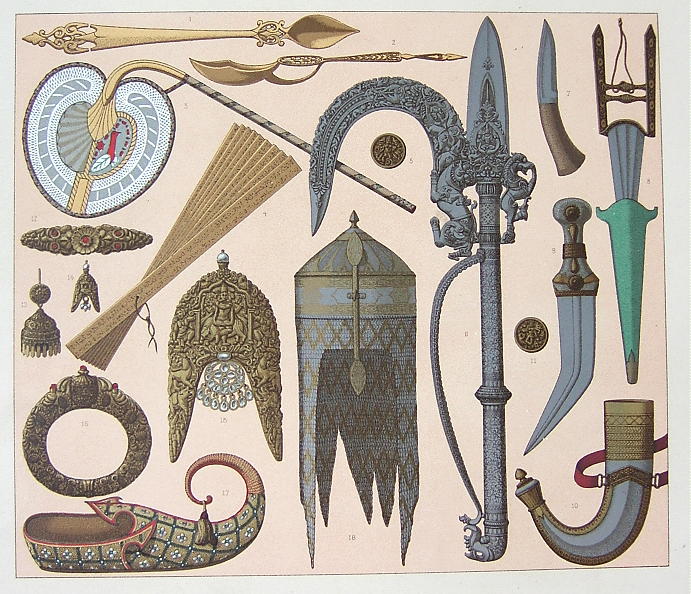

Racinet 1876: some Indian adornments, tools, and weapons
Source: ebay, Nov. 2005
"India, that country full of luxurious vegetation, rich in natural products of every kind, with inexhaustible mines of precious metals and stones, displays her character of overflowing abundance and the fantastic spirit of her inhabitants also in the productions of her art. But notwithstanding her old and comparatively high civilization, a certain conservatism, extending for nearly a thousand years to the social and religious conditions and, institutions, exercised, as a matter of course, its unavoidable influence also on the artistic productions, especially when you look on the caste-like separation of the several trades. Only since the beginning of our century can we report new introductions in the Indian art. Being little conventional and flowing freely, Indian ornament - seems to have the greatest affinity with the Persian style. The surface decoration, never losing its specific character, mostly exhibits a very profuse richness of recurring motives, and a grand splendour of colouring which, far from harassing the eyes of the beholder, affords, on the contrary, a salutary repose to them. The outlines of the design, in which all modelling is avoided, are generally executed on light ground in deeper colours than the pattern itself, and on dark ground-in light colours. The Indians found their principal motives, as seems most likely, among their native plants, employing in the first place lotus, excellently drawn roses, pinks, granates, etc.; but most frequently, especially in modern productions, we meet with the palm-branch always-treated conventionally
Legend:
Fig. 1 and 2. Wooden spoons from Calcutta used for cream, Fig. 3. Bengalese
fan used in Indian homes. The handle is made of wood, the fan part of silk
and satin. The first fans used in India were made of palm leaves. They
were used against flies, also a tail of the yak (Tibetan steer)) was used
for this purpose, Fig. 4. depicts a book made of elongated wooden tablets
tied together with a wire, Figs. 5, 11, 12, 13, 14, 15, and 16. depict
various buttons, brooches, buckles made of embossed and chiseled
gold, embellished with various precious stones, diamonds and pearls, Fig.
6. Antique steel hook used by elephant riders, Fig. 7. Little knife from
Nepal, Fig. 8. A khouttar, Indian dagger, distinguished by its sheath covered
with velvet. This weapon is only known in Hindustan, Figs. 9 and 10. Another
dagger with a bent-shaped blade, strengthened along its length with a raised
rib. This type of dagger was not attached to a belt but was carried hanging
from it, Fig. 17. Depicts a shoe of a nahab. The fabric is made of golden
filaments, embroidered with silk and pearls, Fig. 18. A helmet of a mogul
from the 16th Century, the top is highlighted by a pyramid-shaped button,
the front has the nose protector."